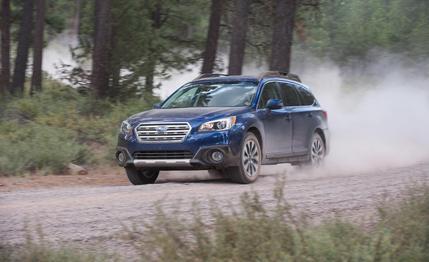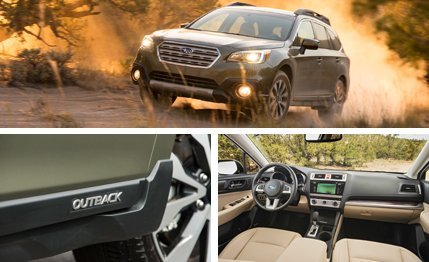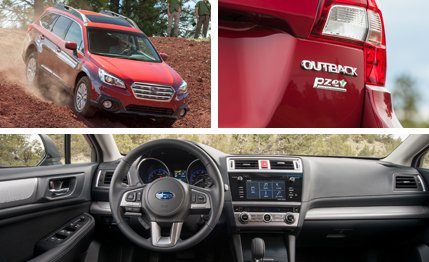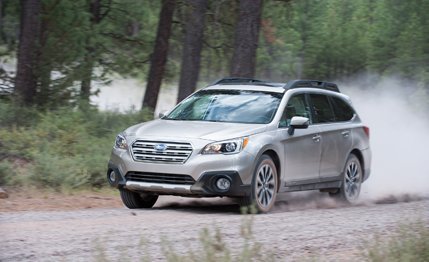 First Drive Review
First Drive Review
Australian pitchman Paul Hogan is long gone from Subaru's team, but the Outback he once peddled is humming along quite well without him. And considering that you haven’t thought about Mick “Crocodile” Dundee in years, you’ve probably been doing just fine without him.
Subaru has redesigned the Outback for 2015, a probably unnecessary move in light of the 120,000 or so Outbacks Subaru sold last year. More than one in every four Subarus sold in the U.S. is an Outback, a factoid that suggests the company could’ve left the outgoing wagon on the vine for a few more years. But a new Legacy sedan arrived a few months ago, so the Legacy-based Outback was next in line for a redo.
The 2015 Outback is a cautious redesign. With the old model selling well, Subaru has stayed true to the Outback formula. But the new model looks sleeker. There’s less plastic cladding, and the front-end styling is cleaner, more cohesive, and less dorky. It’s an altogether better-looking hiking boot. The Outback is now 0.6 inch longer, and the wheelbase is up a touch. Additionally, front-seat occupants will find two more inches of shoulder room.

Sitting in the front seat is also more pleasant, thanks to a redesigned interior with slightly better material quality. How slight? The inside of the glove box is now felt-lined. The instrument-panel design is clean, two large analog gauges stare back from behind the steering wheel, and there’s a standard 6.2-inch touch screen (Premium and Limited trim levels get a 7.0-inch monitor) perched above the climate controls that operates audio, phone pairing, and the optional navigation functions. Rear-seat space is excellent, and there are 73.3 cubic feet of cargo area (with the seats folded), so don’t bother deflating your river raft.
Outback Output
Both engines continue unchanged from last year. A 2.5-liter flat-four with 175 horsepower and 174 lb-ft of torque connects through a CVT and opens at $25,745. Power is adequate, and the characteristic flat-four growl is subdued in this latest application. We’d estimate a 0-to-60 time around nine seconds flat. The EPA predicts fuel economy of 25 mpg in the city and 33 mpg on the highway, an improvement over last year’s 2.5-liter Outback’s 24 city and 30 highway numbers.
Only about 20 percent of Outback customers opt for the 256-hp, 3.6-liter flat-six. The six-pot Outback comes only in the top Limited trim level and starts at $33,845. The smooth-revving flat-six is certainly quicker than the four, but it doesn’t feel impressively so. We’d estimate 0-to-60 times in the mid-seven-second range. Fuel economy comes in at 20 mpg city and 27 mpg highway for the larger engine (3 better in the city and 2 better on the highway than the 2014 six-cylinder model). For 2015, the six gets a CVT instead of a traditional automatic. In the six and four, Subaru’s CVT acts as if it were shifting through gears as it moves through preset ratios. There are even steering-wheel-mounted paddles to call up six preset ratios.

If you don’t pay close attention and refrain from stomping on the Outback’s accelerator, the CVT may fool you into thinking it’s a regular automatic. Although a CVT doesn’t quite jibe with the character of a performance-oriented WRX, the CVT’s slightly sluggish responses don’t rile us as much in a more laid-back car such as the Outback. There’s no manual offered. Should you want a clutch pedal, Subaru will point you toward the Forester crossover.
Driving on All Fours
Permanent four-wheel drive is standard on all Outbacks, and the car's 8.7 inches of ground clearance are enough for almost any off-road trails that you’d care to venture down with baby on board. What the Outback lacks, relative to the small SUVs, is a high seating position. Even though higher than most cars, the Outback doesn’t tower over traffic like an SUV or crossover. The major upsides to this: The Outback drives like a car, and you don’t have to climb into it.
A quicker steering ratio and electric power assist are new for the 2015 Outback. Tactile and secure, the steering nearly works with the precision and feedback of the BRZ sports car. Body roll is kept in check, and there’s surprising sportiness to the Outback that belies its size and tall-aspect-ratio tires. We can give those big, unfashionable sidewalls some credit for the supple ride. Even on rippled dirt roads, the Outback absorbs bumps and big impacts without any bone-jarring jolts or unseemly structural shudders. Subaru claims the structure is 59 percent stiffer in torsion and 35 percent in bending.

If you can’t handle your way out of an accident, the Outback has standard front, front side, curtain, and front-seat-cushion airbags. The first of their kind in a Subaru, the seat-cushion airbags take the place of dash-mounted knee airbags and deploy from the leading edge of the seat-bottom cushions, designed to keep front-seat occupants’ legs from impacting the dashboard.
Safety options include blind-spot monitoring, rear-cross-traffic warnings, adaptive cruise control, and the camera-based collision-warning system that Subaru calls EyeSight. EyeSight mounts two cameras inside the car around the rearview mirror. Equipped with EyeSight, the Outback will automatically stop or slow the vehicle to avoid or mitigate a crash. EyeSight is bundled into several option packages, the least expensive of which costs $1695 and also brings blind-spot monitoring, rear-cross-traffic alert, and a power-operated liftgate.
Like we said, the Outback wasn’t crying out for a redesign. Sure, it wasn’t the prettiest face in the segment, but many buyers turned a blind eye to the styling, and sales remained strong. The 2015 model is better-looking inside and out, quieter, more solid, and it remains a carlike alternative to small crossover SUVs. Unlike those car-based vehicles, the Outback actually is a car, and it’s better for it.